
DogFoodAdvisor is reader supported See how
All reviews are 100% impartial but if you buy using links on this page, we may earn a referral fee.
What’s the best dog food for diabetes?
Diabetes is a relatively common disorder in dogs, with around one in 200 affected.
When it comes to managing diabetes in dogs, it’s important to provide them with a well-balanced diet that helps regulate their blood sugar levels.
You should choose a food which contains lean sources of protein such as skinless chicken, turkey, lean beef or fish. Proteins are essential for maintaining muscle mass and overall health.
Food which includes non-starchy vegetables such as broccoli, cauliflower, green beans, Brussels sprouts, and spinach are also important. These vegetables have a low glycemic index, which means they have minimal impact on blood sugar levels.
Fiber-rich foods can help slow down the absorption of glucose, promoting better blood sugar control. Opt for sources such as pumpkin, sweet potatoes, carrots, and green leafy vegetables.
If you include grains in your dog’s diet, choose wholegrains such as brown rice or quinoa as these contain more fiber and have a lower glycemic index compared to refined grains.
Sources of healthy fats such as fish oil or flaxseed oil, can be beneficial for dogs with diabetes as they help promote a healthy coat and skin.
See our list of the best dog foods for diabetes, but please remember it is important to work closely with your veterinarian to develop a specific meal plan for your diabetic dog. They can provide guidance on portion sizes and specific dietary requirements based on your dog’s individual needs.
You might also find the answers to some of the frequently asked questions we get about dogs and diabetes helpful at the bottom of this page.

Best Dog Food For Diabetes December 2025
Here are The Dog Food Advisor's best dog food brands for diabetes for December 2025.
-
Best Dog Food for Diabetes
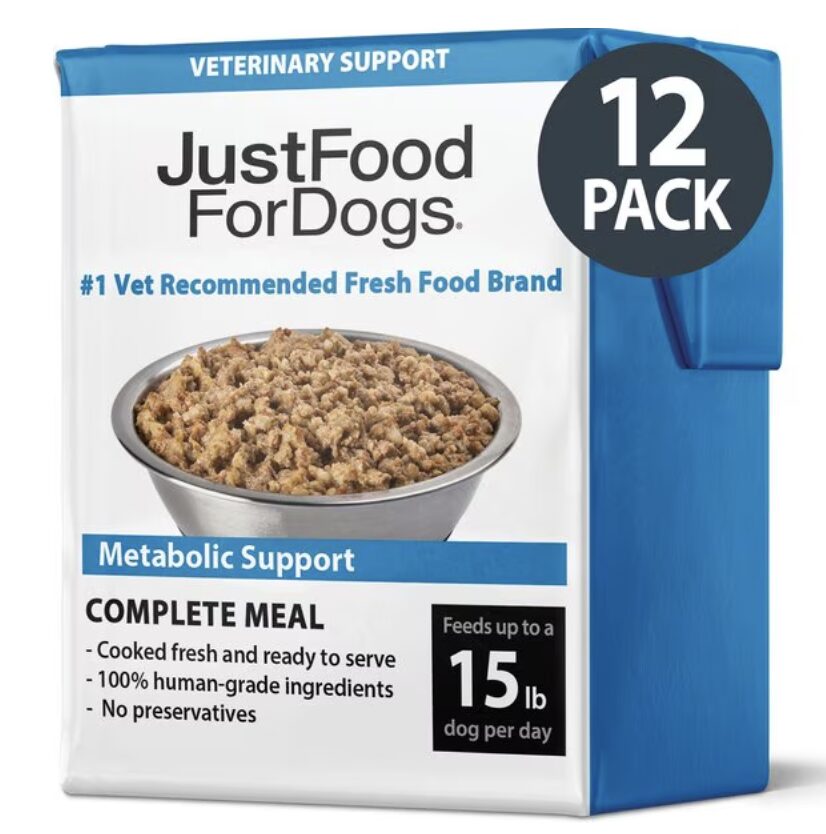
1. Just Food For Dogs Pantry Fresh Metabolic Support
This high fiber recipe is made from fresh, human-grade ingredients and designed to support liver health and promote a healthy metabolism for overweight or diabetic dogs.
It is one of nine recipes in the Pantry Fresh range made by Just Food for Dogs and does not include any preservatives, growth hormones or artificial coloring
The animal protein for this particular recipe comes from fresh turkey. Our dry matter label analysis reveals it contains 41.3% protein, 13% fat and 37.7% estimated carbohydrates, with a fat-to-protein ratio of about 32%.
Things we like
- Human-grade ingredients
- Vet-designed
- High in fiber
Main Ingredients Water, turkey, butternut squash, barley & oats Texture Fresh (Wet) Type Grain-inclusive Protein Percentage 41.3% AAFCO Standards Maintenance Best For Adult dogs only (not puppies) Sample buyer review...
"I have a diabetic dog that is a picky eater and he really likes this food! "
-
Best Premium Diabetic Dog Food
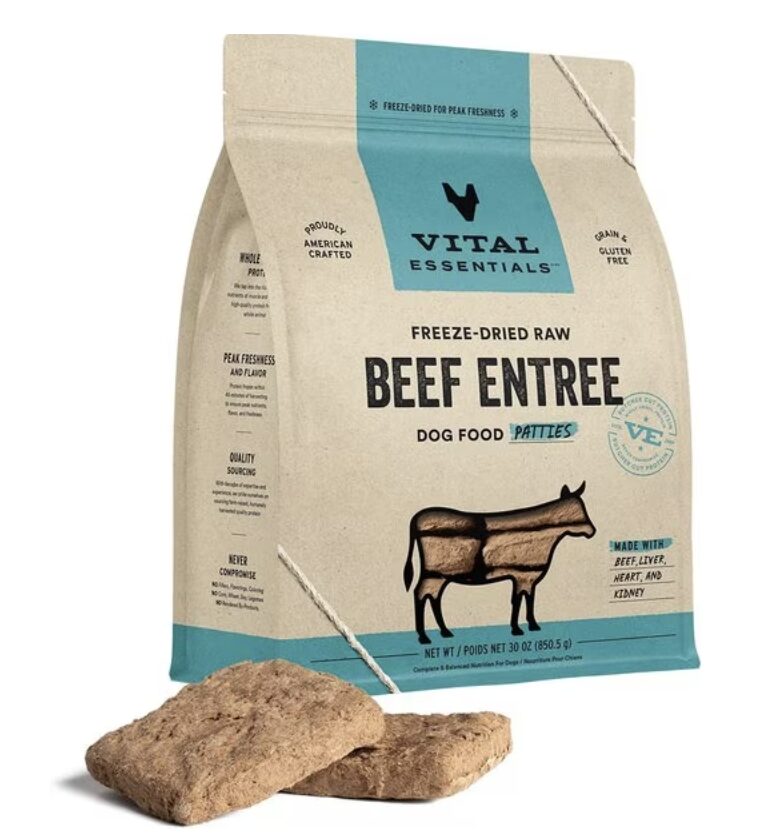
2. Vital Essentials Freeze-Dried Raw Beef Entree Mini Patties
Vital Essentials’ Freeze-Dried Raw Beef Patties are made with butcher-cut protein from muscle, organs, and bone marrow. A raw diet can help diabetic dogs regulate their blood sugar levels and make managing their condition easier.
This recipe derives 100% of its protein sources from beef (meat and organs). Dry matter label analysis reveals the recipe contains 43.5% protein, 34.8% fat and 13.7% estimated carbs… resulting in a fat-to-protein ratio of about 80%.
Things we like
- Limited ingredients
- Regulates blood sugar levels
- Ingredients sourced in the U.S.
Main Ingredients Beef, beef liver, beef heart, beef lung, beef kidney Texture Freeze-Dried Raw (Dry) Type Grain-free Protein Percentage 43.5% AAFCO Standards All Life Stages Best For All dogs including puppies Sample buyer review...
"I love this brand and so does my Yorkie. I put her on a raw diet to help with her dental health and pickiness. I do not have time to prepare my own raw food nor do I feel comfortable making sure she would be getting the nutrition she needs. Vital Essentials is the answer. Top quality ingredients, easy prep, great price point, and my dog LOVES it!"
-
Best Budget-Friendly Diabetic Dog Food
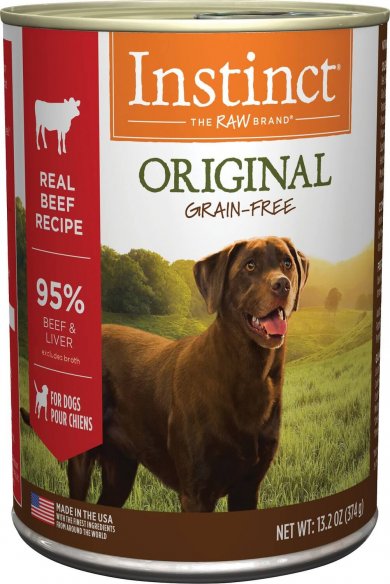
3. Instinct Original Real Beef
Instinct Original Real Beef recipe is packed with animal protein, crucial in a diabetic dog’s diet to help maintain muscle mass and manage blood sugar levels.
The range includes six recipes all balanced with wholesome foods including real meat, fruits and vegetables along with natural sources of omega fatty acids to help promote a shiny coat and healthy skin.
This particular recipe derives the majority of its protein from beef and our dry matter label analysis reveals the recipe contains 52.3% protein, 34.1% fat and 5.6% estimated carbs with a fat-to-protein ratio of about 65%.
Things we like
- High in protein
- Wholesome ingredients
- Rich in omega 3 fatty acids
Main Ingredients Beef, beef liver, beef broth, tricalcium phosphate, ground flaxseed Texture Wet Type Grain-free Protein Percentage 52.3 AAFCO Standards All Life Stages Best For Adults dogs and puppies Sample buyer review...
"Smells tasty, looks palatable, and doable price. Dogs enjoyed it! "
-
Best Dry Dog Food for Diabetes
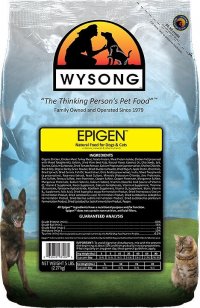
4. Wysong Epigen
Wysong Epigen is a dry food formulated for both dogs and cats. It is designed to mimic a more natural, carnivorous diet, which is especially relevant for managing conditions such as diabetes, where controlling carbohydrate intake is important.
Most commercial dog foods include starches such as rice, potatoes, or grains, which can cause spikes in blood sugar levels. Wysong Epigen avoids these starches, focusing instead on high levels of protein and fat, which can help stabilize blood sugar.
Dry matter label analysis reveals it contains 66.7% protein, 16.7% fat and 8.76% estimated carbs. . . with a fat-to-protein ratio of about 15% and a fat to protein ratio of 25%.
Things we like
- Contains marine microalgae oil
- Organic ingredients
- Starch free
Main Ingredients Organic chicken, chicken meal, turkey meal, potato protein, meat protein isolate Texture Dry Type Starch-free Protein Percentage 66.7% AAFCO Standards Maintenance Best For Dogs (not puppies) Sample buyer review...
"I have a three year old picky Boston terrier but eats this food as well as our cat who immediately went to it!"
-
Best Wet Dog Food for Diabetes
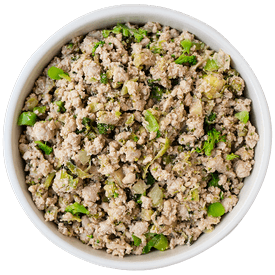
The Farmer’s Dog Chicken Recipe
Chicken Recipe boasts the highest protein content of any product in this fresh food line by The Farmer’s Dog.
This formula is also high in fiber and rich in antioxidants. It has a low glycemic index which means the ingredients are digested and absorbed more slowly, leading to a gradual rise in blood sugar rather than a spike – ideal for diabetic dogs.
Dry matter label analysis reveals this particular recipe contains 46% protein, 25% fat and 21% estimated carbs. . . with a fat-to-protein ratio of about 55%.
Read our review of the full The Farmer’s Dog range here
Things we like
- Fresh
- Contains chelated minerals
- High in fiber
Main Ingredients Chicken, chicken liver, broccoli, cauliflower, brussells sprouts Texture Fresh (Wet) Type Grain-free Protein Percentage 46% AAFCO Standards All Life Stages Best For Dog and puppies Sample buyer review...
Read more buyer reviews at thefarmersdog.com"My dog LOVES the food and I love the convenience and nutritional value!"
-
Best Food for Puppies with Diabetes
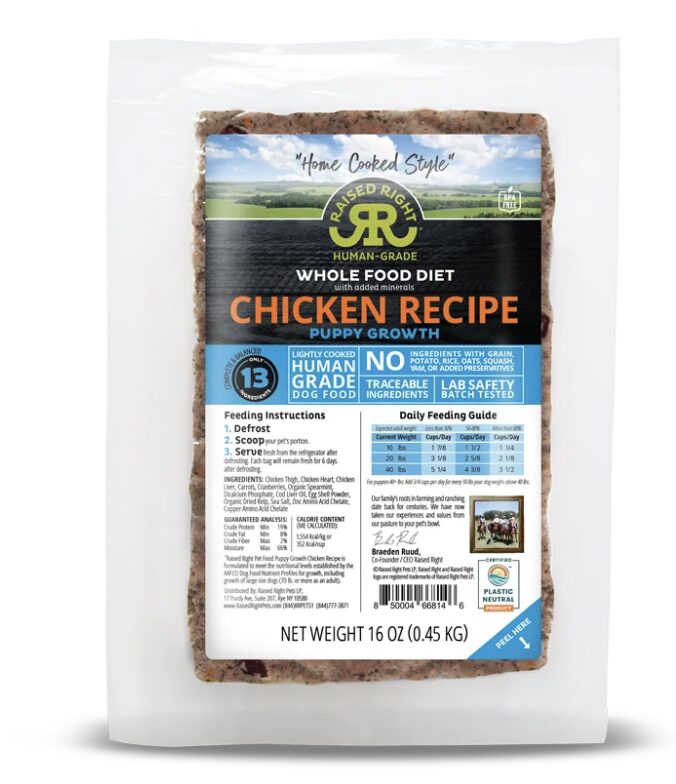
Raised Right Puppy Growth Chicken
This fresh food is formulated by Raised Right specifically for puppies. It is rich in taurine, an amino acid that supports heart health and is essential for proper cardiovascular function. (Diabetic dogs are more prone to heart issues.)
It is one of two Growth recipes and gets the bulk of its protein from chicken. Dry matter label analysis reveals it contains 55.9% protein, 23.5% fat and 12.6% estimated carbs. . . with a fat-to-protein ratio of about 42%.
Things we like
- Taurine
- Quality protein
- Antioxidant-rich
Main Ingredients Chicken thigh, chicken heart, chicken liver, carrots, cranberries Texture Fresh (Wet) Type Grain-free Protein Percentage 55.9% AAFCO Standards Growth Best For Puppies only Sample buyer review...
Read more buyer reviews at RaisedRightPets.com"Having a puppy with allergies and a senior dog undergoing chemo, I am delighted and grateful to have found a food that is not only healthy but delicious for both of my beloved dogs."
More Top Picks
To view more top dog foods by category… click the link below that best meets your personal feeding needs.
Frequently Asked Questions
How is diabetes diagnosed in dogs?
Diagnosing diabetes in dogs typically involves a combination of clinical assessment, physical examination, and specific diagnostic tests.
The veterinarian will inquire about your dog’s overall health, any noticeable symptoms, changes in behavior, and any predisposing factors that could increase the risk of diabetes.
They will then carry out a thorough physical examination, checking for signs such as weight loss, dehydration, changes in coat condition, and overall body condition.
Blood and urine tests are crucial in diagnosing diabetes in dogs. The vet will typically perform the following tests:
- Blood glucose level: A high blood glucose level (hyperglycemia) is a significant indication of diabetes. In some cases, a glucose curve may be conducted to evaluate glucose levels over time
- Glycosuria: The presence of glucose in the urine indicates that the kidneys are excreting excess glucose, suggesting diabetes.
Fructosamine test: This blood test measures average blood glucose levels over the past two to three weeks, providing a broader perspective of glucose control
What are the symptoms of diabetes in dogs?
The main symptoms to look out for are:
- Increased thirst (polydipsia): Dogs may start drinking larger amounts of water than usual
- Frequent urination (polyuria): Dogs may need to urinate more frequently or have accidents indoors
- Increased appetite (polyphagia): Despite eating more, dogs may experience weight loss or have difficulty maintaining weight
- Weight loss: Dogs may lose weight even though their appetite has increased
- Lethargy: Dogs may appear tired, lacking energy, or less active than usual
- Urinary tract infections: Dogs with diabetes are more prone to developing urinary tract infections
- Sweet-smelling breath: Some owners may notice a fruity or sweet odor on their dog’s breath
- Vision problems: In advanced cases of diabetes, dogs may develop cataracts, resulting in cloudy eyes or vision impairment
- Dehydration: Due to increased urination and water intake, dogs with diabetes may become dehydrated
- Poor coat condition: The dog’s coat may become dull, dry, or develop hair loss
What causes diabetes in dogs?
Certain dog breeds are more prone to developing diabetes than others, including poodles, beagles, dachshunds, samoyeds, cairn terriers, and miniature schnauzers.
In some cases, diabetes in dogs is considered an autoimmune disease, where the body’s immune system mistakenly attacks and destroys the insulin-producing cells in the pancreas. This leads to an insufficient production of insulin.
Obesity is also a significant risk factor for diabetes in dogs. Excess body weight can lead to insulin resistance, meaning the body’s cells become less responsive to insulin. As a result, the pancreas produces more insulin to compensate, eventually leading to the pancreas being unable to keep up with the demand.
Inflammation of the pancreas, known as pancreatitis, can disrupt the normal insulin production and secretion. Repeated or severe cases of pancreatitis may increase the risk of developing diabetes.
Certain hormonal conditions, such as Cushing’s disease (hyperadrenocorticism) or an underactive thyroid (hypothyroidism), can affect insulin regulation in the body too and potentially lead to diabetes.
What dietary changes should be made for a diabetic dog?
Dietary changes are an essential aspect of managing diabetes in dogs. The primary goals of the diet for a diabetic dog are to regulate blood glucose levels, maintain a healthy weight, and provide balanced nutrition.
Here are some key considerations:
Feeding your diabetic dog consistent meals at regular intervals is important to help stabilize blood sugar levels. Divide the daily food portion into two or more equally sized meals, given at the same time each day.
Choose a high-quality commercial dog food that is specifically formulated for diabetic dogs or recommended by your veterinarian. Look for diets that are low in carbohydrates and high in fiber, as they can help regulate blood glucose levels. Avoid foods with excessive amounts of sugars, simple carbohydrates, and high-fat content.
Work with your veterinarian to determine the appropriate portion sizes for your diabetic dog. Portion control is crucial to manage weight and blood glucose levels effectively.
Select foods with a low glycemic index (GI). These foods release glucose slowly into the bloodstream, preventing rapid spikes in blood sugar levels. Foods such as whole grains, legumes, and certain vegetables have a lower GI and can be beneficial for diabetic dogs.
Ensure that the diet provides a balanced ratio of proteins, carbohydrates, and fats. High-quality proteins help maintain muscle mass, while complex carbohydrates and moderate amounts of healthy fats contribute to overall nutrition.
Limit or eliminate high-sugar treats and snacks from your dog’s diet. Instead, opt for diabetic-friendly treats or use low-sugar alternatives such as small pieces of cooked lean meat or vegetables.
Establish a routine feeding schedule and avoid free-feeding (leaving food out all the time). This helps with insulin management and monitoring your dog’s appetite.
Can I still give my diabetic dog insulin injections at home?
Yes, in most cases, you can administer insulin injections to your diabetic dog at home. Many dog owners successfully manage their dog’s diabetes by administering insulin injections themselves. However, it is important to work closely with your veterinarian to learn the proper technique and ensure you are using the correct type and dosage of insulin for your dog’s specific needs.
Here are some important points to consider:
Your veterinarian will determine the appropriate type of insulin for your dog, the dosage, and the frequency of administration. They will also teach you how to properly handle and administer the insulin. It is essential to follow their instructions closely.
Insulin injections are typically given under the skin. Your veterinarian will show you the correct technique, which involves pinching a fold of skin and inserting the needle into that fold. They may recommend specific injection sites and rotation to prevent tissue irritation.
Regular monitoring of your dog’s blood glucose levels is crucial to assess the effectiveness of insulin therapy and adjust the dosage if needed. Your veterinarian may teach you how to perform at-home blood glucose monitoring or recommend periodic visits for testing.
Insulin should be stored as instructed by your veterinarian, usually in the refrigerator. Follow proper handling procedures and expiration dates to ensure the insulin’s efficacy and safety.
It is important to prioritize safety while administering insulin injections. Take measures to ensure a calm and controlled environment during the process. Avoid distractions that may startle or stress your dog.
Keep your veterinarian informed about your dog’s progress, any changes in symptoms, and the response to insulin therapy. Regular communication allows your veterinarian to make necessary adjustments to the treatment plan as needed.
It is worth noting that in some cases, if a dog’s diabetes management becomes complex or their condition is unstable, veterinary hospitalization or assistance from a professional veterinary nurse may be required.
Always consult with your veterinarian for personalized advice and guidance specific to your dog’s condition. They can provide detailed instructions and support to help you safely administer insulin injections at home.
How frequently should I monitor my dog’s blood sugar levels?
The frequency of monitoring your dog’s blood sugar levels can vary depending on several factors, including the stability of their diabetes, the type of insulin used, the response to treatment, and any changes in their overall health condition.
What are the potential complications or risks associated with diabetes in dogs?
If not properly managed, diabetes in dogs can lead to various complications including:
- Hypoglycemia: This occurs when blood sugar levels drop too low. It can happen if too much insulin is administered, if the dog doesn’t eat properly, or if there is excessive exercise. Hypoglycemia can be dangerous and may cause weakness, disorientation, seizures, or even coma if not promptly treated.
- Hyperglycemia: This refers to high blood sugar levels, which can occur if the dog’s diabetes is not well-regulated. Prolonged hyperglycemia can lead to dehydration, weight loss, increased susceptibility to infections, and other complications
- Diabetic Ketoacidosis (DKA): This is a severe complication that can occur when a diabetic dog’s body breaks down fats for energy instead of glucose. This process produces ketones, which can build up in the bloodstream, leading to metabolic acidosis. DKA is a life-threatening condition and requires immediate veterinary attention. Symptoms may include lethargy, loss of appetite, vomiting, dehydration, and a distinctive fruity odor on the breath.
- Cataracts: Uncontrolled diabetes in dogs can lead to the development of cataracts. Cataracts cause clouding of the lenses of the eyes, leading to impaired vision or blindness if left untreated
- Urinary Tract Infections (UTIs): Dogs with diabetes are more susceptible to developing urinary tract infections. High levels of glucose in the urine provide a favorable environment for bacterial growth, leading to recurrent infections
- Pancreatitis: Dogs with diabetes are at a higher risk of developing pancreatitis, which is inflammation of the pancreas. Pancreatitis can further disrupt insulin production and regulation, exacerbating diabetes control
- Organ damage: Prolonged uncontrolled diabetes can affect various organs, including the kidneys, liver, heart, and blood vessels. Over time, these complications can impact the overall health and quality of life of the dog
It’s important to note that with proper management, including insulin therapy, appropriate diet, regular exercise, and close veterinary monitoring, the risk of complications can be minimized, and many diabetic dogs can lead happy and fulfilling lives. Regular communication and collaboration with your veterinarian are crucial to address any potential risks or complications promptly.
What is the expected lifespan of a diabetic dog?
The expected lifespan of a diabetic dog can vary depending on various factors, including the dog’s overall health, the success of diabetes management, the presence of other concurrent health conditions, and individual factors such as breed and genetics. With proper management and care, many diabetic dogs can live a happy and fulfilling life.
Generally, diabetic dogs can live for several years with appropriate treatment and monitoring. Some dogs may develop diabetes later in life and may already have underlying age-related health issues, which can impact their overall lifespan. However, with diligent management and regular veterinary care, it is possible to extend their lifespan and maintain their quality of life.
It’s important to note that diabetes is a chronic condition that requires ongoing treatment and monitoring. Regular veterinary check-ups, blood glucose monitoring, insulin administration (if applicable), and adherence to the recommended treatment plan are crucial for managing diabetes effectively and maximizing your dog’s lifespan.
Each dog is unique, and the prognosis can vary. Working closely with your veterinarian, following their recommendations, and maintaining open communication will help ensure the best possible outcome for your diabetic dog. They can provide more accurate insights into your dog’s specific situation based on their individual health status and response to treatment.
Final word
The Dog Food Advisor does not accept money, gifts, samples or other incentives in exchange for special consideration in preparing our reviews.
However, we do receive a referral fee from online retailers (like Chewy or Amazon) and from sellers of perishable pet food when readers click over to their websites from ours. This helps cover the cost of operation of our free blog. Thanks for your support.
For more information, please visit our Disclaimer and Disclosure page.






